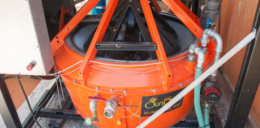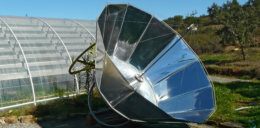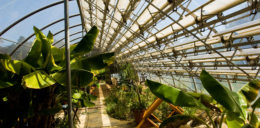Solar Research and Development
Our 240m² research and development workshop is close to the Solar Test Field. Here we carry out our innovative technology research, using approaches to solar energy that extend beyond conventional paradigms. We work on a modular system where humans are seen as part of a whole and healthy world, where cooperation is more rewarding than competition. Our workshop is used as a training center for students, and as a space for maintenance and repair work for the whole of Tamera.
“Sunlight is the finest and most beautiful energy source. We humans are slowly coming closer to understanding how to work with such high energy, and seeing which technical, artistic and spiritual possibilities arise.”
DR. DOUGLAS BAILLIE, physicist in the Solar Test Field
Concept
We’re developing a simple yet complex modular system that delivers energy independence for a village community in the key areas of:
- electricity
- mechanics
- cooking
- heating
- cooling
- transport.
At the same time, we are optimizing plant growth conditions to produce high quality organic food in a small space, and using innovative ways to store thermal energy in gravel and oil. Since 2004, we’ve been working with the physicist and inventor Juergen Kleinwaechter, researching and testing his ecological high-tech innovations in concentrating solar power technologies.
Watch
Areas of Research
We’ve set up a system of prototypes and research on system integration of low temperature stirling engines, the Envelope Power Greenhouse and solar concentrators. We’re honored and inspired to work on the proof of principle for the technology developed by Juergen Kleinwaechter and his team. Currently we’re setting up a new system made up of the different modules of the Hope Container. The Ultralight Membrane Mirror is our current research project. It’s a high-performance, lightweight, low embodied energy optical system for concentrating solar energy – over 1,000 times to deliver heat over 1000°C. It consists of 6 individual mirror segments, each with an inflatable cushion of polymer film 0.1mm thick, floating over a lightweight rigid framework. The precision optical surface needed for high concentration is achieved by air pressure. The focused sunlight is directed to a fixed spot, close to the ground. When the mirror moves, the focused energy can be collected by a static installation.
Watch

- The low temperature Stirling Engine is intended to be a main source of electrical and mechanical power. The engine is constantly heated in one part and cooled in another. The air in between expands when heated and contracts when cooled and this change of pressure drives a piston.

- The SunPulse Water is a solar water pump with a low-temperature Stirling Engine, running on sunlight, using air as its working fluid. It uses zero fossil fuel and creates zero emissions, and is a “stand-alone” system. With an output hydraulic power of 300W it’s ideal for decentralized water provisioning without any additional infrastructure.

- The Envelope Power Greenhouse (EPG) is a greenhouse covered with UV-transparent ETFE (plastic sheeting) where we cultivate organic seedlings for planting in the South Valley. The heat from the greenhouse used to be used as an energy source to drive the SunPulse. As a proof of principle, we used a Fresnel lens system – the roof holds Fresnel concentrators which heat up a series of pipes containing vegetable oil. This circulated in a closed system and was stored in a tank, which retained the heat day and night, and the heated oil powered a kitchen for around 50 people. The hot oil flowed through double-walled cooking pots, so that the heat could be directly used for cooking. The hot oil also drove a low-temperature Stirling motor, the SunPulse Electric, which can produce 1.5 kW. The prototype is no longer in daily use, but we’ve used it when developing our current generation of energy collectors and Stirling engines to be installed in the Test Field as part of our energy autonomy project.

Contribute to community-powered energy autonomy!
Your donation will allow us to demonstrate a component system for carbon-neutral villages in sun-rich regions.

